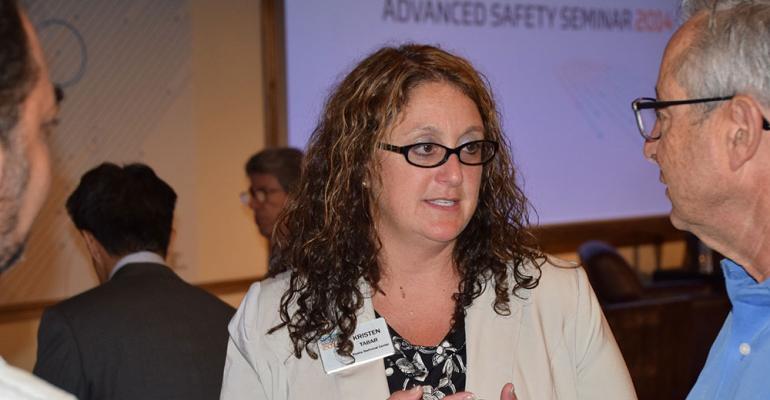YPSILANTI, MI – Self-driving cars will take center stage next week as Detroit hosts the Intelligent Transport Systems World Congress, where automakers, suppliers and universities will display and demonstrate the technologies enabling the era of autonomous mobility.
Pieces of the automated puzzle already are falling into place with a growing number of production vehicles equipped with radar, cameras and sensors enabling adaptive cruise control, blindspot detection, lane-departure warning, automatic emergency braking and camera-guided steering.
What comes next will be the focus of the ITS World Congress, a truly global event that comes to North America every third year. San Francisco hosted it in 2005, followed by New York in 2008, and Orlando, FL, in 2011. Tokyo held the confab last year.
The agenda does not reflect wishful thinking about the futuristic life of George Jetson but instead will highlight practical (and some admittedly far-out) technologies intended to improve freight management, smooth the flow of vehicles on highways and byways, and let cars speak to each other and to a traffic-management infrastructure.
The underlying goal is simple: zero traffic fatalities. Last year, 32,000 people died on U.S. roads, and vehicle accidents represent the leading cause of death among American teenagers. One in 10 highway deaths is due to distracted driving.
Discussions at the Congress also will center on crucial questions about legislation, data protection and liability – specifically, where it rests if a computer-guided car goes the wrong way and causes damage, mayhem, injury or even death.
Leading up to the event, which runs from Sept. 7 to 11, Toyota hosted an Advanced Safety Seminar here Sept. 4 to set the stage for the conference, which is expected to draw 10,000 engineers, technologists, policy makers and business leaders from around the world.
“With the vehicle, people and the traffic environment as the three key players, identifying how the mobility game is played and how the players interact becomes most important,” Seigo Kuzumaki, Toyota’s deputy chief safety technology officer, says at the event here.
Throughout the week, Detroit’s Cobo Center will host panel sessions, keynote speeches, technology sessions and exhibits, while demonstration vehicles will be spotted along Detroit highways and at Belle Isle.
For Toyota, the goal is to demonstrate the capabilities of dynamic radar cruise control and the instances when the vehicle no longer recognizes lane markers and the driver needs to take control.
“These are all real-world conditions that drivers face every day,” says Kristen Tabar, vice president-technical administration planning office at the Toyota Technical Center.
“In those cases, we want to make sure they’re ready to retake control of the vehicle and have that safe driving experience,” she says. “Importantly, this needs to happen in enough time so the driver is alerted.”
Vehicles today are amazingly intelligent and growing moreso, and they are capable of learning a driver’s behavior and preferences, Kuzumaki says. People have bonded with their electronic devices, such as tablets and smartphones, so it is within reason to see consumers connecting with vehicles in the same way.
“Today, I want you to start thinking of the vehicle and the driver as teammates, sharing the common goal of traveling safely,” he says. “The best teammates learn from each other. They watch, listen and remember. They communicate, and they assist, when needed. Over time, a foundation of trust is built.”
He views automated driving functions as similar to antilock brakes and electronic stability control. It took many years, but drivers eventually came to understand these important braking technologies for their ability to keep vehicles from skidding out of control.
The No.1 Japanese automaker steps up its commitment to next-generation mobility by pledging $35 million to its Collaborative Safety Research Center in nearby Ann Arbor to continue its work with agencies, policymakers, academics and the industry to identify research gaps and share findings, tools and analytic models across the industry.
The additional funding will allow the CSRC to extend its studies well beyond 2020, says Chuck Gulash, the center’s director. Toyota claims the CSRC is the only center of its kind.
“We hope to help pave the way for the safe introduction of these new systems, not only by refining the technologies, but also by preparing the drivers who will be using them, with the continued goal of saving lives,” he says.
Since 2011, the CSRC has launched 34 research projects with 17 partner institutions, and seven have been completed in the areas of human factors, active safety and biomechanics. Work has focused on driver distraction and at‐risk traffic populations such as children, teens, pedestrians and seniors.
Toyota was stung with a costly recall of more than 9 million vehicles in 2009 and 2010 to address potential sticking accelerator pedals and floor-mat entrapment. The case was closed earlier this year when Toyota agreed to pay a U.S. government fine of $1.2 billion for failing to report the problem sooner.
The episode was followed by a flood of additional Toyota recalls, including 6.4 million vehicles worldwide this past April for five separate issues.
To bolster vehicle safety, Toyota’s Bill Fay, group vice president and general manager of the Toyota Div. in the U.S., says the automaker will accelerate the availability of active-safety features, including collision prevention, on its entire U.S. lineup.
“We plan to begin the rollout of these technologies in 2015 and hope to have them widely available across our product line by 2017,” Kuzumaki says. “Our goal is to be the world’s first full-line manufacturer to offer such a package on all of its vehicles.”





